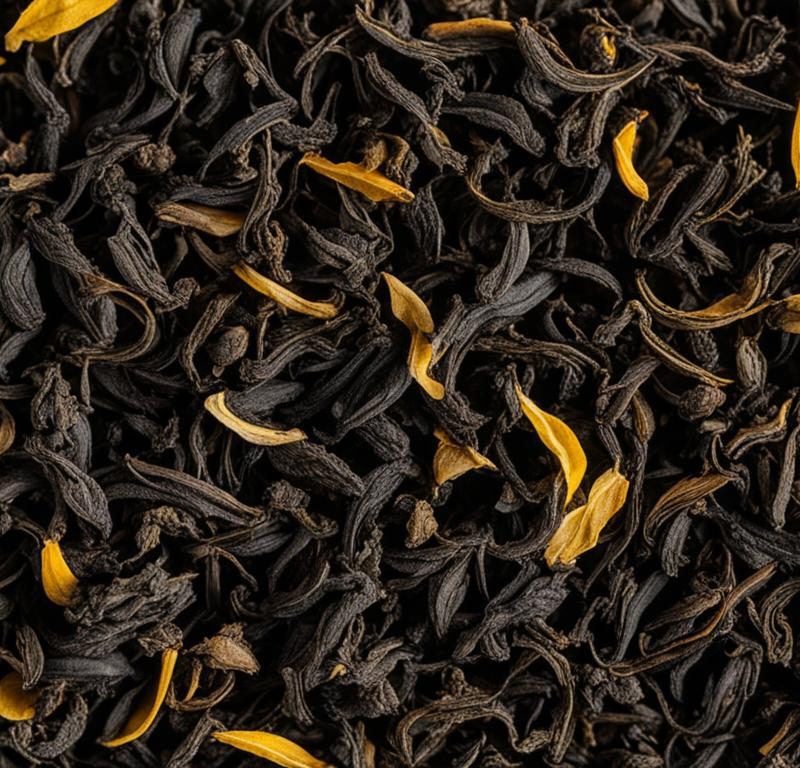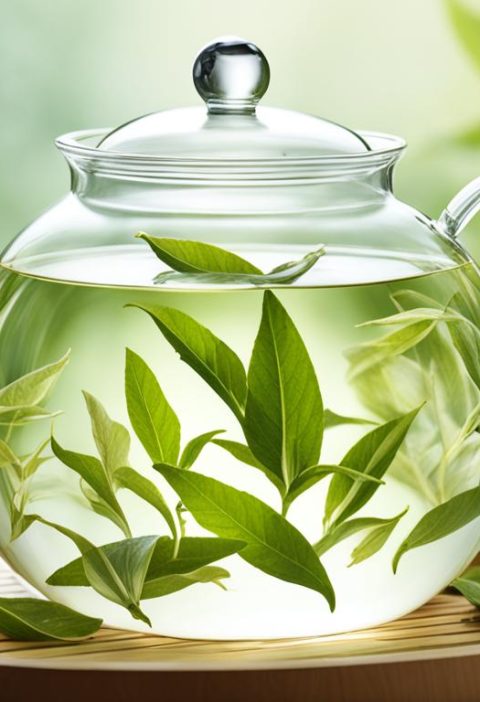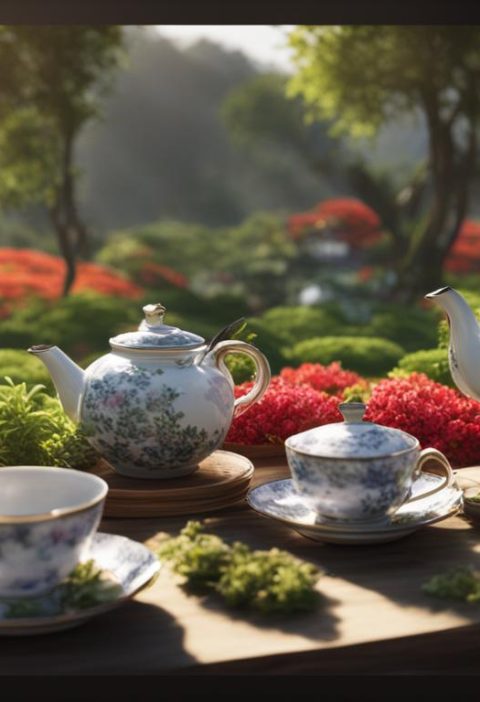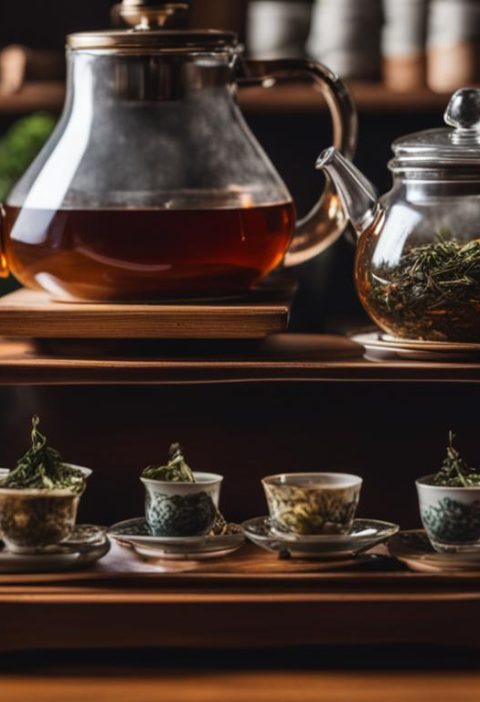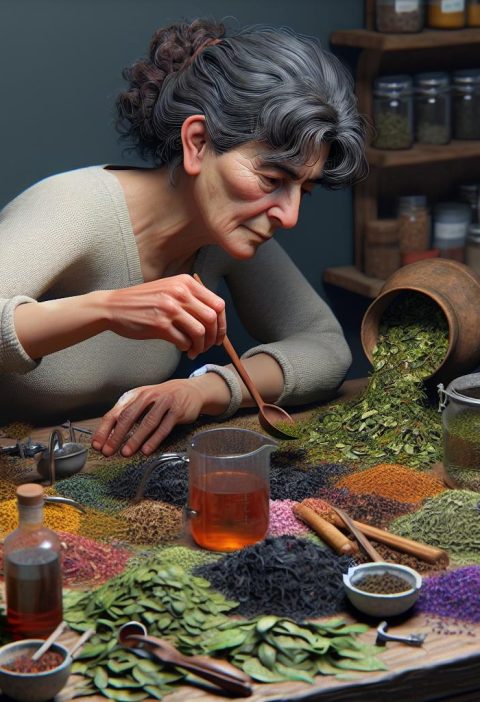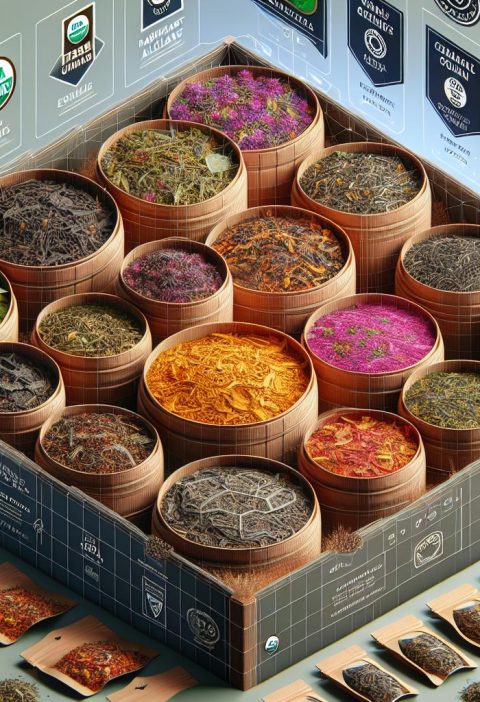Darjeeling black tea is a beloved choice among tea enthusiasts, known for its unique and exquisite flavors. Often referred to as the “Champagne of teas,” it offers a musky-sweet taste reminiscent of Muscat wine. But what exactly are the tasting notes that make Darjeeling black tea so special? In this article, we will delve into the flavors, characteristics, and terroir of Darjeeling black tea to help you gain a deeper understanding of this remarkable beverage. Whether you’re a seasoned tea aficionado or just beginning your tea journey, this guide will provide you with actionable insights to appreciate and savor the complex flavors of Darjeeling black tea.
Key Takeaways:
- Darjeeling black tea is highly prized for its unique flavors, often described as musky-sweet and similar to Muscat wine.
- The taste of Darjeeling tea can range from delicate and vegetal to robust and full-bodied, depending on the harvest flush.
- The flushes of Darjeeling black tea, including first flush, second flush, and autumn flush, offer distinct characteristics and flavors.
- The terroir of Darjeeling, including its high altitude and specific growing conditions, contributes to the tea’s exceptional taste.
- To fully appreciate the flavors of Darjeeling black tea, it is recommended to start with high-quality first flush teas and explore different flushes.
- Darjeeling tea stands out from other Indian teas in terms of flavor and quality, offering a lighter and more delicate taste compared to Assam and Nilgiri teas.
- Brewing Darjeeling black tea requires attention to detail, with recommendations to steep the tea in hot water below the boiling point for under three minutes.
- Exploring Darjeeling-like teas from other Himalayan regions can provide a similar taste experience at potentially lower costs.
- Authentic Darjeeling black tea can be found from select estates in Darjeeling itself or through reputable tea brands that source their teas from the region.
The Flavors of Darjeeling Black Tea
Darjeeling black tea is renowned for its diverse and captivating flavors. From delicate vegetal and mossy notes to fruity undertones, this exquisite tea offers a unique taste experience. Its musky-sweet tasting notes are often compared to the flavors found in Muscat wine, adding to its allure.
The flavor profile of Darjeeling black tea varies depending on the harvest flush. Each flush brings forth distinct characteristics, resulting in a range of flavors that tea enthusiasts can explore. Here’s a breakdown of the flavor profiles associated with different harvest flushes:
First Flush
- Fresh and delicate flavors
- Light-bodied with a subtle sweetness
- Vegetal and floral notes
Second Flush
- Rich and robust flavors
- Wine-like qualities with a musky sweetness
- Hints of ripe fruits and spices
Autumn Flush
- Darker and naturally fruity flavored
- Full-bodied with a distinct earthiness
- Notes of stone fruits and dried leaves
The complexity and depth of flavor in Darjeeling black tea can be attributed to the combination of Chinese tea genetics and the unique terroir of the Indian region. This harmonious blend creates a layered taste that is highly appreciated by tea connoisseurs around the world.
Understanding the Flushes of Darjeeling Black Tea
Darjeeling black tea is a unique and diverse type of tea that undergoes different harvest flushes throughout the growing season. Each flush contributes to the distinct flavors and characteristics of Darjeeling black tea, providing an opportunity for tea enthusiasts to explore and appreciate the range of options available.
Harvest Flushes:
- First Flush: The first flush, which occurs in spring, is highly regarded for producing delicate and verdant teas. These teas are known for their light and refreshing flavors, offering a taste that reflects the awakening of nature after the winter months.
- Second Flush: The second flush is harvested from more mature tea plants, resulting in teas with wine-like flavors. These teas are treasured for their complex and robust profiles, often described as rich, muscatel, and full-bodied.
- Autumn Flush: Also known as the third flush, the autumn flush takes place in the later part of the growing season. This flush produces teas with a darker leaf and a naturally fruity flavor. The teas from the autumn flush are usually full-bodied and have a unique sweetness.
Each flush brings its own charm and provides a different experience for tea connoisseurs. The flavor profiles and aromas vary, allowing tea lovers to explore the diverse range of Darjeeling black teas available.
The Significance of Darjeeling Tea Terroir
The terroir of Darjeeling plays a crucial role in the flavor profile of the tea. The region’s high altitude and specific growing conditions, including soil chemistry, rainfall, and temperature, contribute to the tea’s unique taste. The smaller leaf Camellia sinensis var. sinensis tea plants, which grow in Darjeeling, have different genetics compared to the larger leaf var. assamica commonly found in other parts of India. This combination of factors gives Darjeeling black tea its distinct and authentic flavors that set it apart from other teas.
The terroir of Darjeeling, with its cool temperatures and misty climate, provides the perfect conditions for the cultivation of high-quality black tea. The unique soil composition, known as “Darjeeling loom,” is rich in minerals and imparts a distinct character to the tea leaves. The rainfall patterns and humidity in the region further enhance the growth of the tea plants, infusing them with the flavors of the surrounding environment.
Darjeeling’s terroir also influences the genetic makeup of the tea plants. The smaller leaf var. sinensis used in Darjeeling black tea has adapted to the high altitude and cooler temperatures, resulting in leaves that are rich in flavor compounds and aromatic oils. Compared to the larger leaf var. assamica, the var. sinensis imparts a more delicate and nuanced taste to the tea.
Moreover, the skilled tea producers in Darjeeling have mastered the art of cultivating, harvesting, and processing tea to preserve its unique flavors. The leaves are carefully hand-plucked and expertly processed to bring out the finest qualities of the tea. This attention to detail, combined with the natural elements of the region, results in the production of authentic Darjeeling black tea that is highly sought after by tea connoisseurs around the world.
Recommendations for Tasting Darjeeling Black Tea
To fully appreciate the flavors of premium Darjeeling black tea, we recommend starting with high-quality first flush teas. These delicate and smooth teas offer a genuine taste of the mountain air flavors that are unique to Darjeeling. Their subtle notes and refreshing qualities allow you to truly experience the essence of this exceptional tea.
Once you have explored the first flush teas, we encourage you to delve deeper into the world of Darjeeling black tea by trying second flush and autumn flush teas. These flushes offer a different flavor profile, with more pronounced wine-like flavors and natural fruitiness. Each flush provides a distinct and delightful experience, showcasing the diversity of Darjeeling black tea.
While Darjeeling black tea is highly sought after, it is worth exploring Darjeeling-like teas from other Himalayan regions, such as Nepal. These teas share similar growing conditions and offer a comparable taste experience at a potentially lower cost. It’s an opportunity to expand your palate and explore the nuances of Himalayan tea.
Whether you decide to stick with Darjeeling tea or venture into its regional counterparts, the key is to choose premium quality teas that are sourced from trusted producers. This ensures that you are getting the authentic flavors and experience that Darjeeling black tea is renowned for.
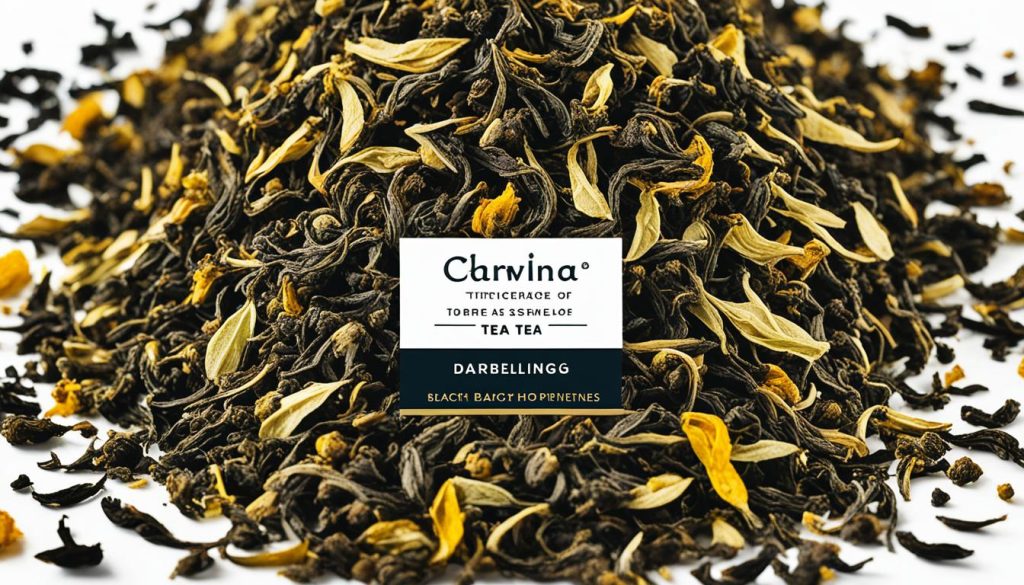
| Tea Flush | Flavor Profile |
|---|---|
| First Flush | Delicate and smooth with notes of fresh vegetation and floral hints. |
| Second Flush | Robust and wine-like, with a musky-sweet taste and hints of ripe fruit. |
| Autumn Flush | Full-bodied with natural fruity flavors and a darker leaf. |
Differentiating Darjeeling Tea from Other Indian Teas
While India is known for its tea production, Darjeeling tea stands out from other Indian teas in terms of flavor and quality. Unlike the robust and malty Assam tea, which is grown in the low-lying regions, Darjeeling tea offers a lighter and more delicate taste. In comparison to Nilgiri tea from the southern region of India, Darjeeling tea is known for its layered complexity. The terroir, specific flushes, and unique processing techniques make Darjeeling tea distinct and highly prized among tea connoisseurs.
When comparing Darjeeling tea to Assam tea, the differences are evident not only in taste but also in the growing conditions and processing methods. Darjeeling tea is grown in the picturesque hills of the Darjeeling region at an altitude of up to 6,000 feet. This high-altitude terroir, combined with the cool temperatures and misty weather, infuses the tea leaves with unique flavors and aromas. On the other hand, Assam tea is cultivated in the low-lying plains of Assam, where the warmer climate results in bolder, robust flavors.
Nilgiri tea, which hails from the southern state of Tamil Nadu, is another well-known Indian tea. While both Darjeeling and Nilgiri teas are grown in mountainous regions, Darjeeling tea stands out with its more intricate flavor profile. Darjeeling tea is characterized by a delicate balance of floral, fruity, and muscatel notes. In contrast, Nilgiri tea tends to have a bolder and fuller-bodied taste with hints of citrus and floral undertones.
The differences between these teas can be summarized as follows:
| Darjeeling Tea | Assam Tea | Nilgiri Tea |
|---|---|---|
| Lighter and more delicate taste | Robust and malty flavor | Bolder with citrus and floral undertones |
| High-altitude terroir | Low-lying plains | Mountainous regions |
| Complex and layered flavor profile | Strong and bold taste | Full-bodied with hints of citrus |
Darjeeling tea’s unique characteristics and exceptional taste have earned it a significant following among tea enthusiasts worldwide. Whether you prefer the delicate flavors of Darjeeling, the boldness of Assam, or the fuller-bodied Nilgiri, each tea offers a distinct and enjoyable experience.
The Art of Brewing Darjeeling Black Tea
Brewing Darjeeling black tea requires some attention to detail to bring out its full flavors. The delicate nature of Darjeeling tea leaves calls for a careful brewing process, which includes considerations such as the water temperature, steeping time, and leaf-to-water ratio. By following a few simple steps, you can enjoy a perfect cup of Darjeeling black tea every time.
Water Temperature:
Darjeeling black tea is best steeped in water that is heated just below boiling point, around 95°C (203°F). Boiling water can scorch the delicate leaves and result in a bitter taste. For a more nuanced and balanced flavor, opt for slightly cooler water.
Leaf-to-Water Ratio:
For an optimal brew, use one teaspoon of Darjeeling black tea leaves for every 8 ounces of water. Adjust the quantity according to your preference for a stronger or milder cup of tea. As a general guideline, aim for approximately 2 grams of tea leaves per cup.
Steeping Time:
The steeping time for Darjeeling black tea varies depending on the type of tea and personal preference. As a starting point, steep the tea for 2-3 minutes. For a lighter and more delicate cup, steep for a shorter duration, around 2 minutes. If you prefer a stronger brew, you can extend the steeping time up to 4 minutes. However, be cautious as over-steeping can result in a bitter taste.
Serving:
After the appropriate steeping time, strain the brewed tea into a teapot or directly into your teacup. You can enjoy Darjeeling black tea as a standalone beverage or pair it with your choice of accompaniments, such as biscuits or pastries.
Experimentation and exploration are encouraged when brewing Darjeeling black tea. As you gain experience and become familiar with the different Darjeeling teas available, you can fine-tune the brewing process to suit your taste preferences. Remember, brewing tea is an art form, and finding the perfect balance is as unique as the tea itself.
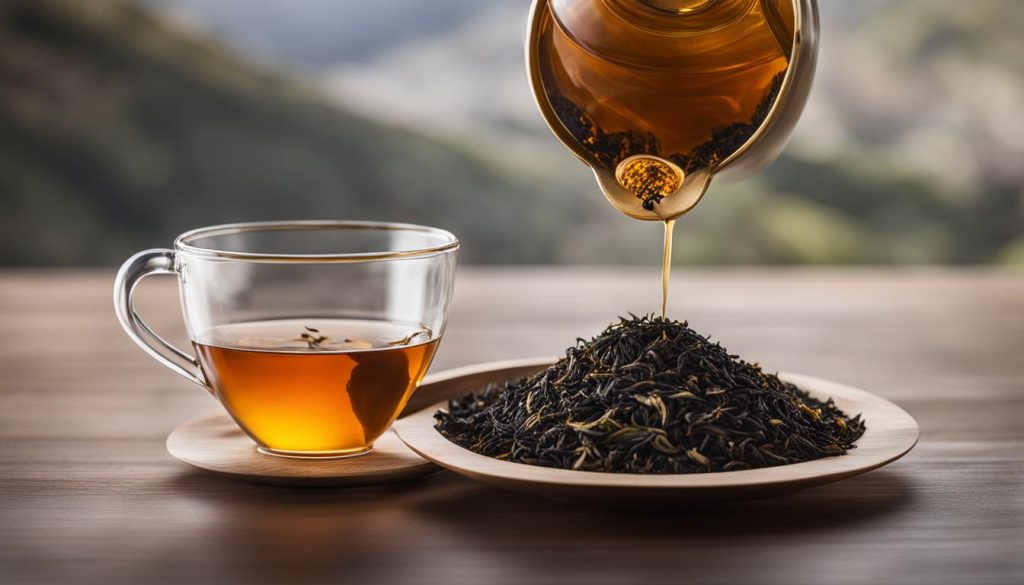
Tea Brewing Tips:
- Use high-quality Darjeeling black tea leaves for the best flavor.
- Preheat your teapot or teacup to maintain optimal brewing temperature.
- Store Darjeeling black tea in an airtight container away from light, heat, and humidity to maintain freshness.
- Try different variations of Darjeeling black tea, such as first flush, second flush, and autumn flush, to explore their unique flavors.
- Consider using filtered or spring water for brewing Darjeeling black tea to enhance the taste.
Recommended Darjeeling Black Tea Brewing Guide:
| Darjeeling Black Tea Type | Water Temperature | Steeping Time | Leaf-to-Water Ratio |
|---|---|---|---|
| First Flush | 95°C (203°F) | 2-3 minutes | 1 teaspoon per 8 ounces of water |
| Second Flush | 95°C (203°F) | 2-4 minutes | 1 teaspoon per 8 ounces of water |
| Autumn Flush | 95°C (203°F) | 3-4 minutes | 1 teaspoon per 8 ounces of water |
Exploring Darjeeling-like Teas
While Darjeeling black tea is highly sought after, there are also Darjeeling-like teas grown in other Himalayan regions, such as Nepal. These teas offer similar flavors and growing conditions at potentially more affordable prices. Exploring Darjeeling-like teas can provide a taste experience comparable to authentic Darjeeling tea, allowing tea enthusiasts to broaden their palate and discover new flavors. These teas can be a great alternative or addition to Darjeeling black tea in the quest for unique and exquisite tea experiences.
For those looking to explore Darjeeling-like teas, here are some Himalayan regions to consider:
| Region | Flavor Profile | Availability |
|---|---|---|
| Nepal | Similar to Darjeeling with musky-sweet notes; floral and fruity undertones | Widely available from reputable tea retailers |
| Sikkim | Mild and floral with hints of muscatel; fresh and smooth flavors | Available in limited quantities; specialty tea shops |
| Bhutan | Delicate and vegetal; subtle hints of flowers and herbs | Rare and limited availability; small-scale tea producers |
Exploring teas from these regions can provide a diverse range of Darjeeling-like options, each with its own unique characteristics. Whether you’re looking for a more affordable alternative or simply want to expand your tea collection, Darjeeling-like teas offer a compelling and delicious choice.
Where to Find Authentic Darjeeling Black Tea
If you’re craving the distinct flavors of Darjeeling black tea, you’re in luck. Authentic Darjeeling tea can be easily sourced from select estates in Darjeeling itself or through reputable tea brands that specialize in sourcing teas from the region.
When purchasing Darjeeling black tea, it is essential to ensure its authenticity and quality. Look for tea brands that carry the label “Darjeeling Tea” as certified by the Tea Board of India. This guarantee ensures that you’re getting the real deal, sourced from the revered Darjeeling region.
For a curated selection of high-quality Darjeeling teas that truly showcase the authentic flavors of the region, turn to experienced tea masters in the Darjeeling tea industry. They have the expertise to handpick the finest teas crafted by skilled artisans.
Whether you prefer to purchase directly from tea estates in Darjeeling or through trusted online retailers, you can indulge in the exquisite flavors of Darjeeling black tea without compromising on quality. Discover the charm of Darjeeling through every sip, and embark on a journey of unparalleled taste.
